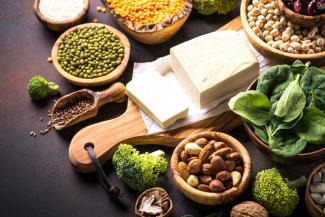What does it take to "green" your plate?

Every time we hear about healthy eating, we know that fruits and vegetables will be at the top of the list of recommended choices. However, many of us struggle with incorporating these items into our diet.
The Academy and Nutrition of Dietetics created the Healthy Eating Plate to make this a little easier. It suggests filling half your plate with vegetables and fruits as part of an optimal diet. This concept helps us to have a better idea of what our plates should look like, but it doesn’t detail how to vary those fruits and vegetables to maximize nutrient intake.
An easy way to increase your greens is to make sure that each week, 1 ½ cups of those veggies on your plate are dark green. Green leafy vegetables are vital to a healthy, balanced diet. They are rich in vitamins A, C, E, K, and B vitamins. They contain an abundance of antioxidants that protect cells and promote heart health, and we find high levels of fiber, iron, magnesium, potassium and calcium in these foods that are essential for the body.
Some of these powerhouse green veggies are: arugula, bok choy, collard greens, kale, mustard greens, Swiss chard, spinach, cabbage, watercress, romaine lettuce, and broccoli. Try to alternate every day or at least each week. Another great tool to vary them is to eat them seasonally to make sure you maximize your nutrient intake and it will prevent you from getting bored!
How to add them in your diet:
• Start with what you know and enjoy. There are likely some vegetables that you already like, so try to keep a list, and add them as a snack or with a meal throughout the day. Aim to try one new green vegetable per week.
• Purchase dark green vegetables fresh or frozen. Organic frozen spinach and broccoli are high-quality ingredients and particularly useful to keep on hand for quick additions to frittatas, stir-fries, soups, and sides.
• Make a pesto sauce or add them to your scrambled eggs or omelet in the morning!
• Wrap it up. Make a wrap with tuna, chicken, or turkey, and add romaine lettuce, spinach, arugula, and other veggies for added flavor.
• Add to soup. Add greens with larger, tougher leaves such as collard greens, kale, or mustard greens into your favorite soup.
• Stir-fry it. Add chopped spinach, bok choy, or broccoli to chicken or tofu stir-fried with olive or canola oil with some garlic, onion, and ginger.
• Steam it. Steam collard greens, mustard greens, kale, or spinach until they are slightly soft.
Besides the nutritional part of it, is important to mention that planning our meals around produce benefits the planet as well. Since we are moving to a more conscient way of eating, shifting to a more plant-based diet will help reduce freshwater withdrawals and deforestation—a win-win for both our personal health and the environment.
